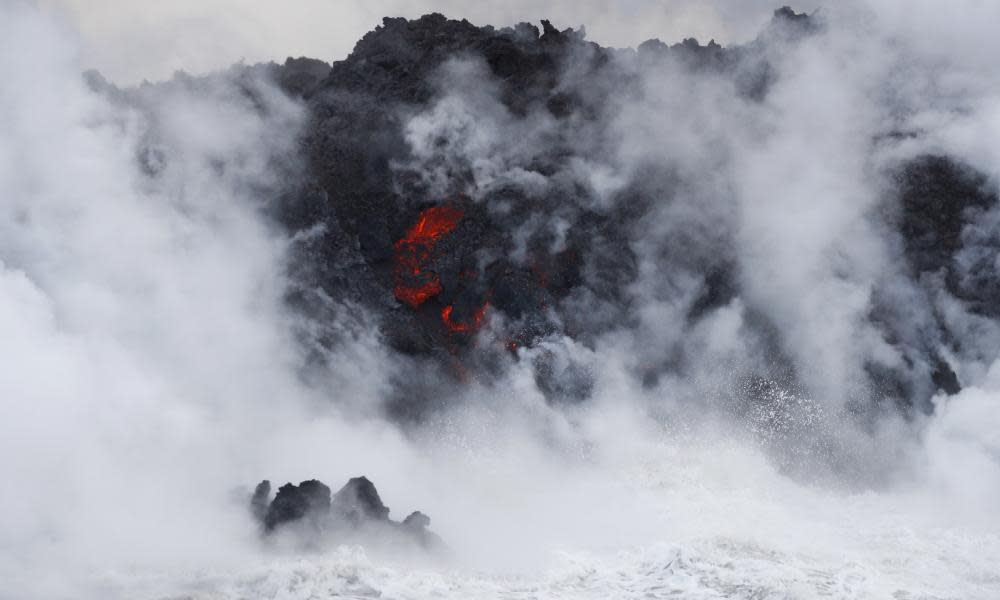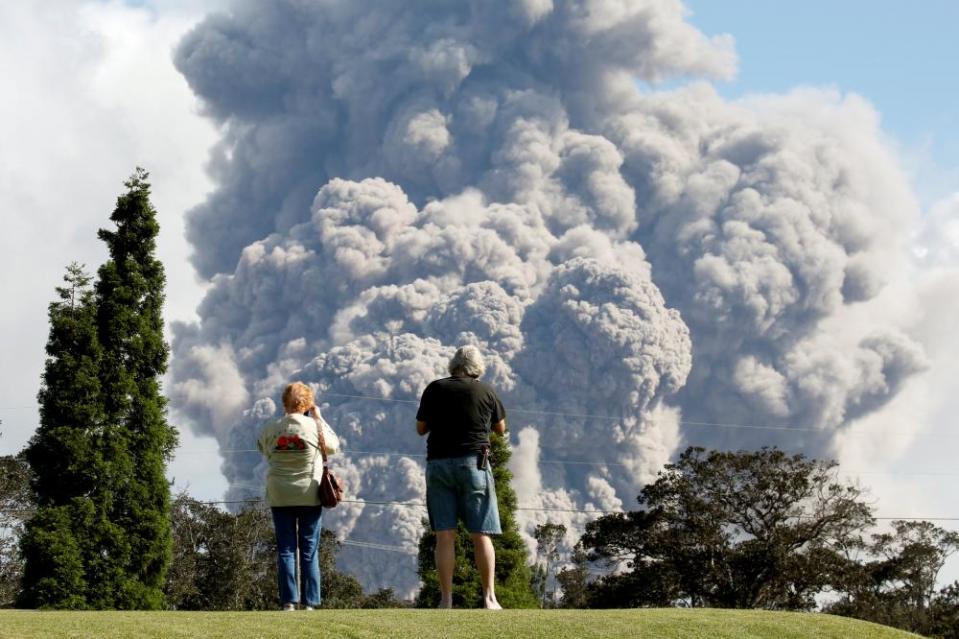'Lava haze' and 'vog': toxic volcanic gases prompt health fears in Hawaii

Three dozen tourists were gathered at the Wailoa Sampan Basin Harbor in Hilo, Hawaii, hoping to get a glimpse of the lava that they’d seen on the news for weeks.
But because Hawaii Volcanoes national park – often a key stop in travelers’ itineraries – was closed after Kilauea erupted, their best hope on Monday afternoon was taking a boat to the point where the lava met the sea.
Some said they’d packed breathing masks, just in case the trade winds — which usually blow in clean sea air — changed direction and began blowing a lava haze, a noxious mix of gases and particles, their way.
Although many tourists to Hawaii island – the Big Island – choose to visit because of the active volcano, some have gotten more than they bargained for since the eruption. (Petra Wiesenbauer, who runs a popular Pahoa lodge near the park, had to hurry three guests out of the door while she and her neighbors fled the lava and toxic fumes.)
Up until lava crossed Highway 137 late Saturday night and entered the ocean, volcanic smog, called vog, which contains mostly sulfur dioxide and acid particles, along with ash, had been the biggest air quality concern.
But then the molten rock began pouring into the cool seawater and added clouds of lava haze or “laze”. Officials warned people to stay away since the plumes can travel up to 15 miles downwind, according to the Hawaii Volcano Observatory.
The clouds form when hot lava boils seawater, creating tiny shards of volcanic glass and hydrochloric acid that then get carried in steam. The plumes can be deadly.
The USGS says on its website: “This hot, corrosive gas mixture caused two deaths immediately adjacent to the coastal entry point in 2000, when seawater washed across recent and active lava flows.” Hawaii civil defense cautioned people on Monday to “stay away from the ocean plume since it can change direction without warning”. In the case of laze and vog, store-bought respirators filter particles but not hydrochloric acid or sulfur dioxide.
Vog and laze can cause eye irritation, skin irritation and respiratory issues, according to officials. Those with conditions like asthma or cardiovascular disease are most sensitive, as are the elderly, children and pregnant women, according to an interagency group of volcano experts. Even before the recent Kilauea eruption, Hawaii already suffered air quality issues from volcanic gases. The island of Hawaii has the highest sulfur dioxide (SO2) emissions in the nation, according to EPA spokesman Dean Higuchi. And according to a 2016 report published in the scientific journal Environmental international, levels were “1,000 times greater” than the EPA’s definition of a major pollution source.
There has been a moderate increase in the number of people coming into Hilo medical center for treatment of vog-related symptoms since the eruption, according to Elena Kabatu, a hospital spokesperson. But she said that many more were likely experiencing the less serious effects of vog, such as dry eyes or a scratchy throat.
For those living in Pahoa, near the lava, conditions vary depending on whether the trade winds are blowing, residents said. Gilbert Aguinaldo, who has offered his vacant, central Pahoa lot to serve as a hub of locally organized community aid, said that volunteers were loaning out respirators and breathing masks to anyone who needs them.

“We are a little worried about the laze,” said Heather Lippert, 40, who was waiting to board the boat for the lava tour, “But I’m sure they’ll try to keep us safe.”
Vanessa Homyak, 36, said she and Lippert, who are from San Diego, had originally intended to stay at an Airbnb in Pahoa when they scheduled their vacation. But after the eruption began, the pair reconsidered. “We called the host and asked how things were,” she said. “They said, ‘If we were you, we would probably stay somewhere else.’”
They took the advice, staying instead on the other side of the island. But though they were out of the path of the lava, they discovered that they were directly in the path of the vog.
“We saw it when we flew into Kona, this big brown layer in the air,” Lippert said.
Erik Jacobs, who lives in Waikoloa, in the north-west part of the island and had just returned from a two-week vacation, said the vog was already irritating his eyes, making them feel dry and scratchy. He said his neighbors told him the vog was the “worst they’d ever seen” on the Big Island late last week.

 Yahoo News
Yahoo News 
